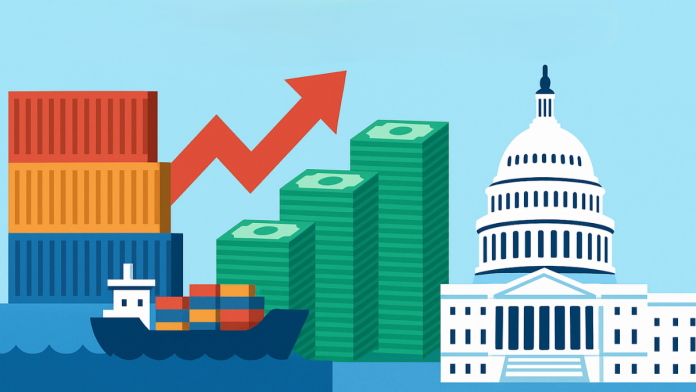The latest numbers from the Congressional Budget Office (CBO) show that President Donald Trump’s recent hikes in tariffs are bringing in far more money than expected. According to the nonpartisan agency, the new tariffs are projected to cut federal deficits by $4 trillion over the next ten years.
Tariffs are taxes on goods imported from other countries. When these goods enter the U.S., importers pay extra charges, which go straight into federal revenue. The CBO says that the higher tariff rates are now about 18 percentage points above last year’s level.
This increase means the government needs to borrow less money. As a result, interest payments on the national debt are also expected to drop by around $700 billion. Taken together, that’s $3.3 trillion less in primary deficits and $700 billion less in interest costs.
The CBO report explains that this is a big jump compared to the June estimates, when it had projected only $2.5 trillion in lower deficits and $500 billion in reduced interest outlays. The difference comes from more tariff hikes being applied across a wider range of goods, including imports from China, Canada, and Mexico, as well as products like automobiles and steel.
Trump warns China over magnets, threatens 200% tariff if supply is curbed
Tariffs Offset Rising Costs of New Spending
The CBO report also noted that these extra revenues from tariffs could help balance out new spending and tax cut measures. Trump’s recently signed One Big Beautiful Bill Act is expected to add $3.4 trillion to federal deficits. The surge in tariff money could cover a large share of that cost.
Still, the agency made clear that the numbers depend on the current tariff system staying in place. Ongoing legal challenges and trade negotiations may affect how much money comes in from these import taxes.
Outside experts are also studying the numbers closely. The Committee for a Responsible Federal Budget (CRFB), a nonpartisan watchdog group, calculated that Trump’s tariff system could reduce the deficit by up to $2.8 trillion over the next decade. They called the revenue “meaningful” and “significant.” However, their estimate was made before the CBO updated its figures to reflect the most recent hikes.
The CRFB has also run scenarios where courts strike down some of the tariffs. In those cases, the deficit savings would shrink. The CBO’s updated $4 trillion estimate shows how large the impact could be if the tariffs continue unchanged.
Debt Levels Add Pressure to Fiscal Debates
The U.S. national debt currently stands at around $37 trillion. That growing number has already put pressure on borrowing costs, as higher debt can lead to higher interest rates. The new tariff revenues help reduce some of that pressure by lowering the amount of new borrowing needed.
India contracts lobbying firms in the US to address tariffs and oil sanctions
Lawmakers are also facing a key funding deadline at the end of September. With federal spending and deficits under debate, the new CBO numbers are expected to play a role in the discussions.
While the tariffs are reducing deficits, some experts point out that the costs often fall on American businesses and shoppers. Import taxes work like a sales tax, meaning that everyday consumers may end up paying more at stores. That is one reason why critics say the deficit savings come directly from households and not from foreign countries.
The CBO emphasized that its estimates rely on data from the Census Bureau, Customs and Border Protection, and the Treasury Department. Using those sources, the agency has adjusted its short-term forecast for 2025 through 2028 and extended the outlook for a full decade.
The numbers confirm that President Donald Trump’s tariffs are now a major source of federal revenue, cutting into the deficit at levels not seen in earlier reports. With $4 trillion in potential savings, the impact on U.S. finances is significant, especially as debates continue over spending, tax cuts, and the nation’s rising debt.
